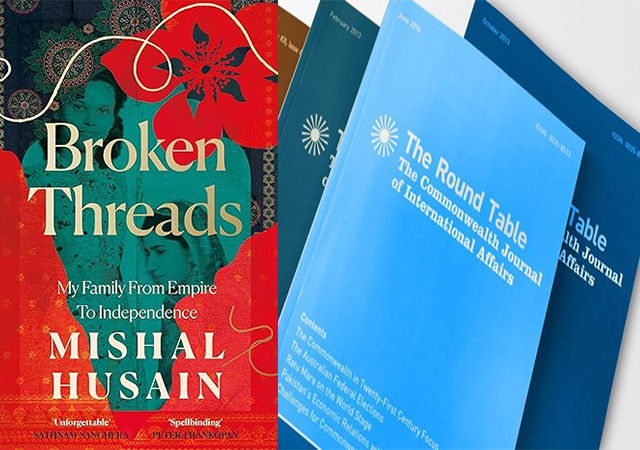
[This is an excerpt from an article in The Round Table: The Commonwealth Journal of International Affairs.]
It takes true dedication to write about one’s family. And for a journalist with Mishal Husain’s high profile – visible on British television screens and audible on the radio – perhaps doubly so. By describing the lives of her four grandparents, she has gone back in time to chart their experiences against the backdrop of one of the most traumatic and momentous events of 20th century South Asian history – the partition of India and the creation of two new dominions: India and Pakistan (initially in two wings before the secession of Bangladesh in 1971). Her motivation is clear – inspired by her first visit to India as a BBC journalist. ‘I soaked up the atmosphere of a great city loved by my grandparents, and lost to them in 1947; I used my Urdu, was replied to in Hindi, and found common understandings as well as language everywhere I went’ (p. 2).
Drawing upon tape recordings, letters and memoirs left by her grandparents and other family members, as well as interviews with those still living, Mishal Husain paints a wonderfully vivid portrait as she pieces together their individual stories. Her narrative begins in Imperial India – four people living in different parts of the country: her grandfathers, Syed Shahid Hamid, born in Lucknow and Mumtaz Husain, born in Multan, her grandmothers, Tahirah Butt, born in Aligarh and Mary Quinn, born in Narsipatnam in Anakapalle district in south India. Her early chapters follow their respective stories as they meet and marry. A particularly interesting insight into cross-cultural relationships in the early 1940s is the description of Mumtaz’s marriage to Mary, a devout Roman Catholic, whose father was Irish and mother a young Indian of Hindu faith. Despite opposition to the union by Mumtaz’s family, both Mary, aged 20, and Mumtaz, aged 22, wanted their marriage to be sanctified by their own religious rituals – beginning with a nikah ceremony in a mosque followed by a church service the following day. ‘Mary and I belonged to each other in the eyes of man and God, the union having been cemented in the manner our respective beliefs ordained, in the mosque and now in church’, Mumtaz later wrote (p. 53).
Pakistan at 75: A mixed record
Books Review: The Fragrance of Tears and The Bhutto Dynasty
A day in the life of India’s elections
Shahid’s marriage to Tahirah was more straightforward since both were Muslim. But even so, there were challenges. Shahid was a young soldier in the Indian Army and although the war, which had already begun in Europe, seemed far away, his movements were subject to military schedules, and he and Tahirah married sooner than her family would have liked. Yet, up to this point, their lives were relatively uncomplicated. It was not until war came to the frontiers of India that tension increased, complemented by the increasingly vociferous demand by Indian politicians for independence from British rule.
Divided into three parts ‘Citizens of Empire’, ‘Before Midnight’ and ‘After Midnight’, it is in the second section that the reader is drawn not just into the personal but also the political story of their lives. Shahid’s career as a soldier not only gave him a ringside view of India at war but, as private secretary in the post-war period to General Sir Claude Auchinleck, Commander-in-Chief of the Indian Army, exceptional insight into the tortuous negotiations towards independence ‘with access to the Chief’s paperwork, including confidential information’, (p. 173). Initially, the expectation was that the subcontinent would remain united, perhaps as a loose federation including over 560 princely states comprising one-third of the subcontinent’s landmass. But, as the negotiations took their inexorable path, with, as Husain says, the majority not being able to assuage the fears of the minority, the realisation dawned that partition was inevitable.
No story about independence and partition would be complete without a description of the horrors endured by those who went by train fleeing from one side or the other. ‘All alike had been driven from their homes by the exigencies not of war’, writes Husain, citing the words of Penderel Moon in his seminal work, Divide and Quit, ‘but of freedom. It did not make sense, but it had to be endured’, (p. 245). The tragedy of what so many suffered came close to home when, as Husain describes, but for the intercession of an RAF doctor who insisted they travel by plane, Mumtaz and Mary would have taken a train, ‘which became one of the notorious “ghost trains” of that time, arriving at Lahore full of bodies’, (p. 234).
For her grandparents – as well as for countless others – independence signified not only freedom from colonial rule but loss when the reality of what partition would actually mean became apparent.
Victoria Schofield is a member of the Round Table Editorial Board.
Broken threads, my family from empire to independence by Mishal Husain, London, 4th Estate, 2024.



